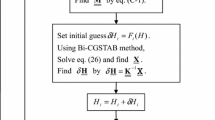Abstract
We introduce a numerical methodology to compute the solution of an adhesive normal contact problem on rough surfaces with the Boundary Element Method. Based on the Fast Fourier Transform and the Westergaard’s fundamental solution, the proposed algorithm enables to solve efficiently the constrained minimization problem: the numerical solution strictly verifies contact orthogonality and the algorithm takes advantage of the constraints to speed up the minimization. Comparisons with the analytical solution of the Hertz case prove the quality of the numerical computation. The method is also used to compute normal adhesive contact between rough surfaces made of multiple asperities.








Similar content being viewed by others
References
Bemporad A, Paggi M (2015) Optimization algorithms for the solution of the frictionless normal contact between rough surfaces. Int J Solids Struct 69:94–105
Campañá C, Müser MH (2006) Practical green’s function approach to the simulation of elastic semi-infinite solids. Phys Rev B 74:075,420
Campañá C, Müser MH, Robbins MO (2008) Elastic contact between self-affine surfaces: comparison of numerical stress and contact correlation functions with analytic predictions. J Phys Condens Matter 20(35):354,013+
Carbone G, Bottiglione F (2008) Asperity contact theories: Do they predict linearity between contact area and load? J Mech Phys Solids 56(8):2555–2572
Carbone G, Mangialardi L (2004) Adhesion and friction of an elastic half-space in contact with a slightly wavy rigid surface. J Mech Phys Solids 52(6):1267–1287
Carbone G, Mangialardi L (2008) Analysis of the adhesive contact of confined layers by using a green’s function approach. J Mech Phys Solids 56(2):684–706
Carbone G, Scaraggi M, Tartaglino U (2009) Adhesive contact of rough surfaces: comparison between numerical calculations and analytical theories. Eur Phys J E 30:65–74
Carpick RW, Ogletree DF, Salmeron M (1978) A general equation for fitting contact area and friction versus load measurements. J Colloid Interface Sci 211:395–400
Chaudhury MK (1996) Interfacial interaction between low-energy surfaces. Mater Sci Eng R Rep 16(3):97–159
Derjaguin B, Muller V, Toporov Y (1975) Effect of contact deformations on the adhesion of particles. J Colloid Interface Sci 53(2):314–326
Greenwood JA (2006) A simplified elliptic model of rough surface contact. Wear 261(2):191–200
Greenwood JA, Williamson JBP (1966) Contact of nominally flat surfaces. Proc R Soc Lond A 295:300–319
Hu YZ, Tonder K (1992) Simulation of 3-D random rough surface by 2-D digital filter and fourier analysis. Int J Mach Tools Manuf 32:83–90
Hyun S, Pei L, Molinari JF, Robbins MO (2004) Finite-element analysis of contact between elastic self-affine surfaces. Phys Rev E 70(2):026,117+
Johnson KL, Kendall K, Roberts AD (1971) Surface energy and the contact of elastic solids. Proc R Soc Lond A 324(1558):301–313
Longuet-Higgins MS (1957) Statistical properties of an isotropic random surface. Philos Trans R Soc A 250(975):157–174
Maugis D (1992) Adhesion of spheres: the JKR-DMT transition using a Dugdale model. J Colloid Interface Sci 150(1):243–269
Müser MH (2014) Single-asperity contact mechanics with positive and negative work of adhesion: influence of finite-range interactions and a continuum description for the squeeze-out of wetting fluids. Beilstein J Nanotechnol 5:419–437
Nguyen QS (2000) Stability and nonlinear solid mechanics, Wiley
Paggi M, Ciavarella M (2010) The coefficient of proportionality k between real contact area and load, with new asperity models. Wear 268(7–8):1020–1029
Pastewka L, Robbins MO (2014) Contact between rough surfaces and a criterion for macroscopic adhesion. Proc Natl Acad Sci 111(9):3298–3303
Pei L, Hyun S, Molinari JF, Robbins MO (2005) Finite element modeling of elasto-plastic contact between rough surfaces. J Mech Phys Solids 53(11):2385–2409
Persson BNJ (2001) Theory of rubber friction and contact mechanics. J Chem Phys 115(8):3840–3861
Persson BNJ (2002) Adhesion between elastic bodies with randomly rough surfaces. Phys Rev Lett 89:245,502
Polonsky I, Keer L (1999) A numerical method for solving rough contact problems based on the multi-level multi-summation and conjugate gradient techniques. Wear 231(2):206–219
Putignano C, Afferrante L, Carbone G, Demelio G (2012) A new efficient numerical method for contact mechanics of rough surfaces. Int J Solids Struct 42:338–343
Signorini A (1933) Sopra alcune questioni di elastostatica. Atti della Societa Italiana per il Progresso delle Scienze
Stanley HM, Kato T (1997) An FFT-based method for rough surface contact. J Tribol 119:481–485
Westergaard H (1937) Bearing pressures and cracks. J Appl Mech 6:49–53
Wriggers P (2006) Computational contact mechanics. Springer Science and Business Media, New York
Yastrebov VA, Anciaux G, Molinari JF (2015) From infinitesimal to full contact between rough surfaces: evolution of the contact area. Int J Solids Struct 52:83–102
Acknowledgements
Support for V.R. from the EPFL Fellows fellowship programme co-funded by Marie Skodowska-Curie, Horizon 2020 Grant agreement no. 665667 is gratefully acknowledged.
Author information
Authors and Affiliations
Corresponding author
Rights and permissions
About this article
Cite this article
Rey, V., Anciaux, G. & Molinari, JF. Normal adhesive contact on rough surfaces: efficient algorithm for FFT-based BEM resolution . Comput Mech 60, 69–81 (2017). https://doi.org/10.1007/s00466-017-1392-5
Received:
Accepted:
Published:
Issue Date:
DOI: https://doi.org/10.1007/s00466-017-1392-5




